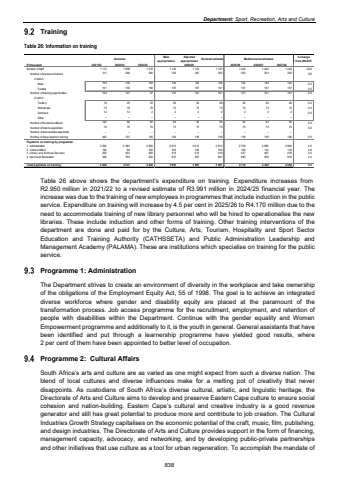Page 859 - Demo
P. 859
Department: Sport, Recreation, Arts and Culture Training Table 26: Information on training Outcome Main appropriationAdjusted appropriation Revised estimate Medium-term estimates % change from 2024/25R thousand 2021/22 2022/23 2023/24 2025/26 2026/27 2027/28Number of staff 1 112 1 098 1 018 1 123 1 123 1 123 1 449 1 449 1 449 29.0Number of personnel trained 311 280 290 303 303 303 303 303 303 0.0of whichMale 150 130 140 146 146 146 146 146 146 0.0Female 161 150 150 157 157 157 157 157 157 0.0Number of training opportunities 100 107 97 101 101 101 101 101 101 0.0of whichTertiary 18 25 25 26 26 26 26 26 26 0.0Workshops 70 70 70 73 73 73 73 73 73 0.0Seminars 12 12 2 2 2 2 2 2 2 0.0Other %u2013 %u2013 %u2013 %u2013 %u2013 %u2013 %u2013 %u2013 %u2013Number of bursaries offered 120 80 80 84 84 84 84 84 84 0.0Number of interns appointed 70 70 70 73 73 73 73 73 73 0.0Number of learnerships appointed %u2013 %u2013 %u2013 %u2013 %u2013 %u2013 %u2013 %u2013 %u2013Number of days spent on training 400 120 130 136 136 136 136 136 136 0.0Payments on training by programme1. Administration 2 200 2 385 2 500 2 612 2 612 2 612 2 729 2 855 2 983 4.52. Cultural Affairs 150 50 100 104 104 104 109 114 119 4.83. Library and Archives Services 250 300 400 418 418 418 437 457 478 4.54. Sport and Recreation 350 796 820 857 857 857 895 936 978 4.4Total payments on training 2 950 3 531 3 820 3 991 3 991 3 991 4 170 4 362 4 558 4.52024/25Table 26 above shows the department%u2019s expenditure on training. Expenditure increases from R2.950 million in 2021/22 to a revised estimate of R3.991 million in 2024/25 financial year. The increase was due to the training of new employees in programmes that include induction in the public service. Expenditure on training will increase by 4.5 per cent in 2025/26 to R4.170 million due to the need to accommodate training of new library personnel who will be hired to operationalise the new libraries. These include induction and other forms of training. Other training interventions of the department are done and paid for by the Culture, Arts, Tourism, Hospitality and Sport Sector Education and Training Authority (CATHSSETA) and Public Administration Leadership and Management Academy (PALAMA). These are institutions which specialise on training for the public service. Programme 1: Administration The Department strives to create an environment of diversity in the workplace and take ownership of the obligations of the Employment Equity Act, 55 of 1998. The goal is to achieve an integrated diverse workforce where gender and disability equity are placed at the paramount of the transformation process. Job access programme for the recruitment, employment, and retention of people with disabilities within the Department. Continue with the gender equality and Women Empowerment programme and additionally to it, is the youth in general. General assistants that have been identified and put through a learnership programme have yielded good results, where 2 per cent of them have been appointed to better level of occupation. Programme 2: Cultural Affairs South Africa%u2019s arts and culture are as varied as one might expect from such a diverse nation. The blend of local cultures and diverse influences make for a melting pot of creativity that never disappoints. As custodians of South Africa%u2019s diverse cultural, artistic, and linguistic heritage, the Directorate of Arts and Culture aims to develop and preserve Eastern Cape culture to ensure social cohesion and nation-building. Eastern Cape%u2019s cultural and creative industry is a good revenue generator and still has great potential to produce more and contribute to job creation. The Cultural Industries Growth Strategy capitalises on the economic potential of the craft, music, film, publishing, and design industries. The Directorate of Arts and Culture provides support in the form of financing, management capacity, advocacy, and networking, and by developing public-private partnerships and other initiatives that use culture as a tool for urban regeneration. To accomplish the mandate of 838


